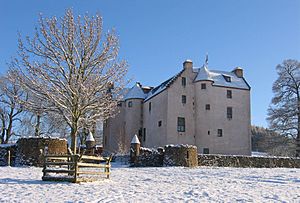Hatton Castle, Angus facts for kids
Hatton Castle is a historic building in Angus, Scotland. It stands on Hatton Hill, part of the Sidlaw Hills. The castle is located south of the village of Newtyle. From the castle, you can see amazing views across Strathmore. You can even spot distant mountains like Ben Lawers and Schiehallion.
This castle was built in the 1500s. It was designed as a strong country home, known as a "Z-plan" tower house. This means it had a special shape for defense. Before this castle, an older one called Balcraig Castle stood nearby on Hatton Hill.
Contents
What's in a Name? The Story of "Hatton"
The name "Hatton" comes from a farm close by. It's a shorter way of saying Hall-toun. In Scots language, toun means a farm. So, "Hatton" means "the farm near the Hall." This suggests a main building, or "Hall," was there first. The farm next to it is now called Hatton Farm.
Why is it Called "Newtyle"?
Hatton Castle was probably first known as "Newtyle Castle." The word tyle in Scots means a roofing stone. This isn't just for clay tiles, but also for stone. Newtyle likely refers to the sandstone found and used nearby. This stone was used for building, walls, and even for carving Pictish stones. Many of these ancient stones are at the Meigle Sculptured Stone Museum. The name "Newtyle" might mean there was an older place where this special stone was dug up.
A Glimpse into Hatton Castle's Past
The area around Hatton Castle has a long history. Long ago, Picts lived here. For example, the Eassie Stone was found nearby. This shows that Pictish people were skilled carvers. They accepted Christianity around the year 600 AD.
Early Owners of the Land
In 1317, Robert the Bruce gave these lands to Sir William Olifard. Later, Robert the Bruce's daughter, Elizabeth, married Sir William's son, Sir Walter Olifaunt. In 1364, Walter's brother, David II, confirmed that the Newtyle estate belonged to them.
Building the Castle
The castle we see today was built in 1575. It was ordered by Laurence, fourth Lord Oliphant. Hatton Castle is special because it has a "scale and platt staircase" built right into its original design. This type of staircase was usually only found in much bigger buildings. Lord Oliphant also made another of his castles, Kellie Castle in Fife, much larger. That castle looks quite similar to Hatton.
Life at the Castle and a Cannon Story
After the Oliphants, many different people lived in Hatton Castle. One story tells of an old Scots custom. The Lords Oliphant would keep a cannon pointed at the nearby road. This was to make travelers come inside and enjoy their hospitality. It was a way to get news and information! A cannon is still there today. Hatton Castle was often home to the younger sons of the Oliphant family.
From Ruin to Restoration
Around 1720, Hatton Castle lost its roof. This happened after the 1715 Jacobite rising. A new Italian-style home, Belmont Castle, was built nearby. Hatton Castle slowly became covered in ivy and home to birds.
Later, the castle was sold for reconstruction. It was carefully rebuilt to look much like it did in 1575. The windows even have hand-made glass from Edinburgh. Under-floor heating was added to keep it warm without visible radiators. The outside walls were covered with a traditional pinkish lime plaster.
Hatton Castle Today
Today, Hatton Castle is a family home. The current owners continue to restore it with help from experts. The castle still has a strong room. In old times, this room would have been like a bank for valuable items. There is also a "priest hole" in what was the main bedroom. This secret hiding place might have been used for more than just priests!
The castle has an amazing Great Hall. It measures about 34 by 17 by 17 feet. This room has fantastic acoustics, meaning sound travels very well. Music is often played in the Great Hall, just like in the 1500s. Many dances and concerts are held there. It's a popular spot for Scottish traditional musicians. The castle has hosted many talented artists from around the world. American cellist Abby Newton even recorded her album Castles, Kirks and Caves in the Great Hall. In the gardens, a group called the Handlebards performs Shakespeare's plays using pedal-powered transport!
The Castle Gardens
We don't have records of Hatton Castle's first gardens. But a house this grand would surely have had beautiful gardens long ago. The buildings of Hatton Farm might even stand where an old garden used to be.
New Life for the Gardens
Until the 1990s, Hatton Castle was surrounded by fields with sheep and cattle. Now, a new garden is growing around the castle. It features impressive dry-stane dyking, which are walls built without mortar. Some of these walls are up to three meters high! They are the work of a master wall-builder named Duncan Armstrong.
An orchard has been planted with old Scottish apple types. There are also mulberry trees. The sunken vegetable garden grows fig trees and artichokes. The eastern edge of the garden follows the old Dundee and Newtyle Railway. This was the first railway line in northern Scotland. It was built to carry flowers from Newtyle farms to Dundee. From there, the flowers would travel by ship to Edinburgh. The old "bulb factory" was next to Newtyle station, which still exists today.


